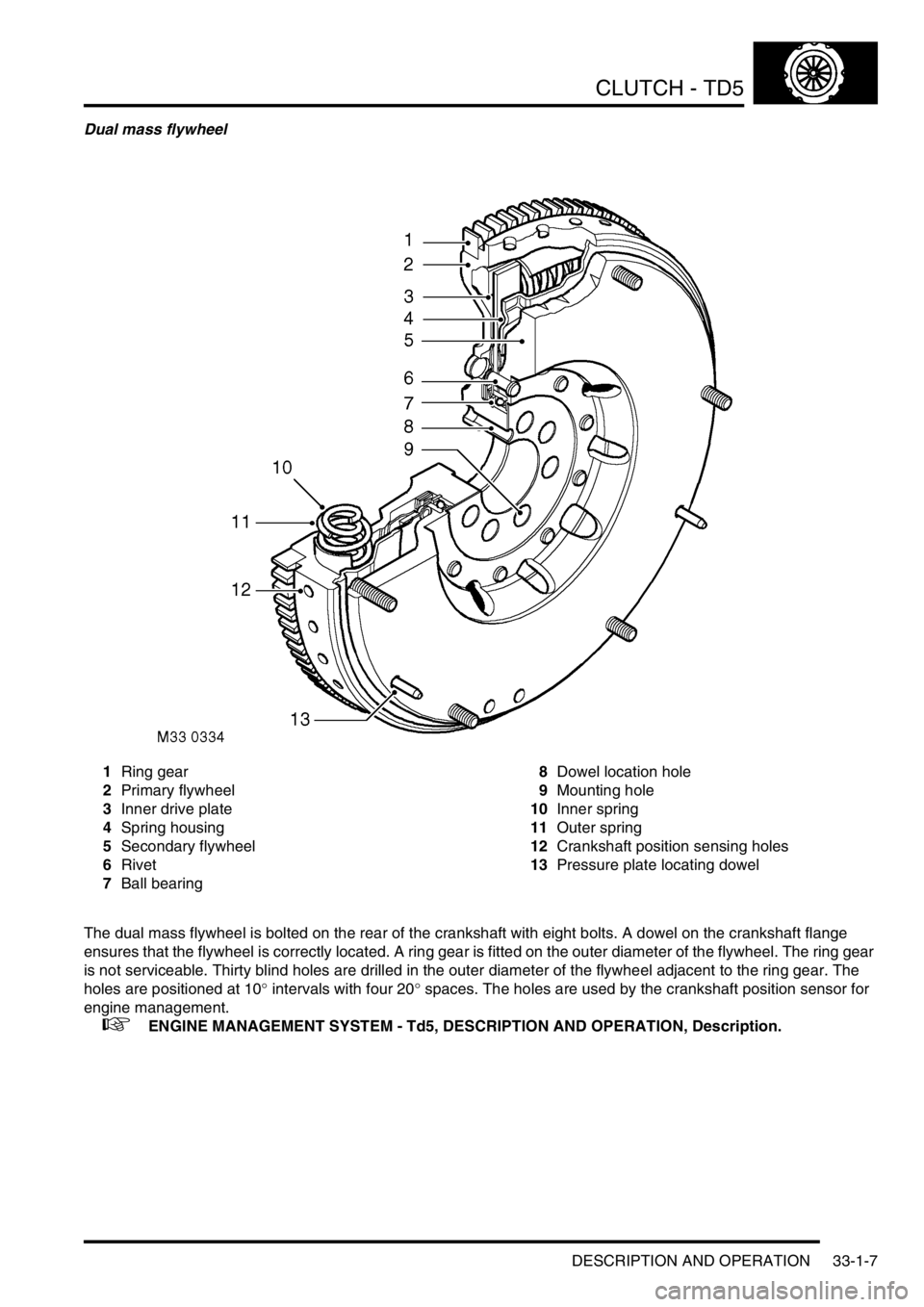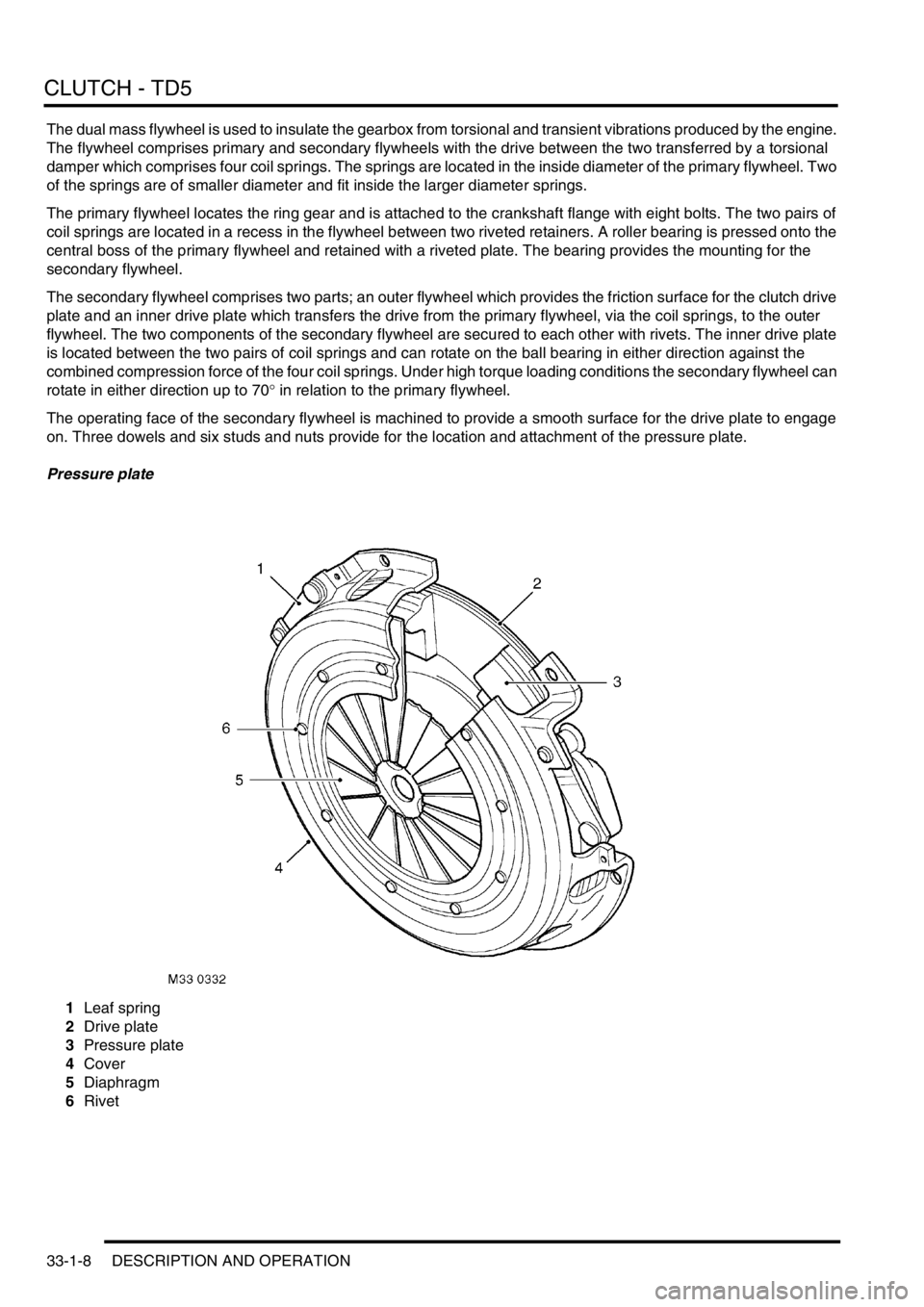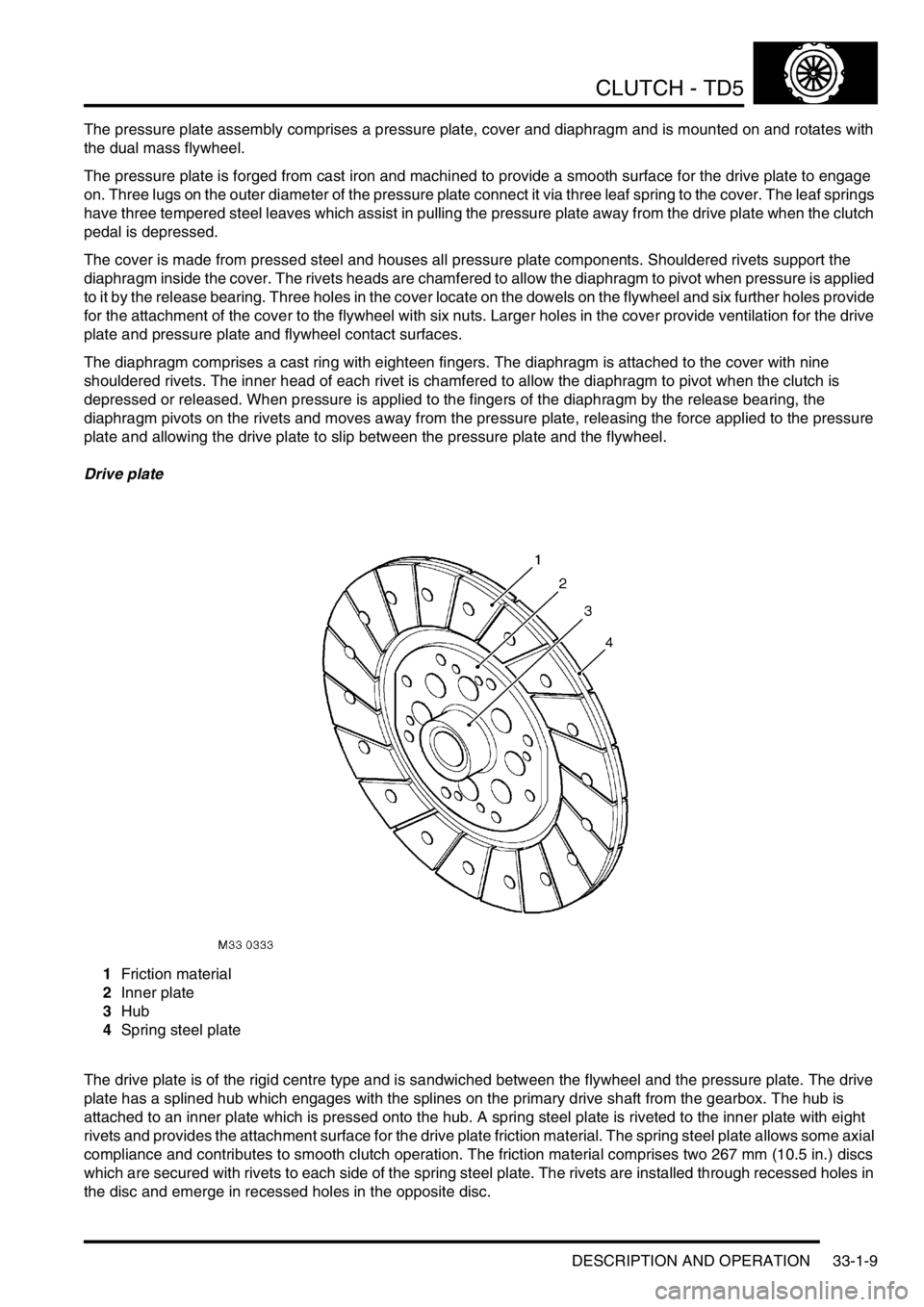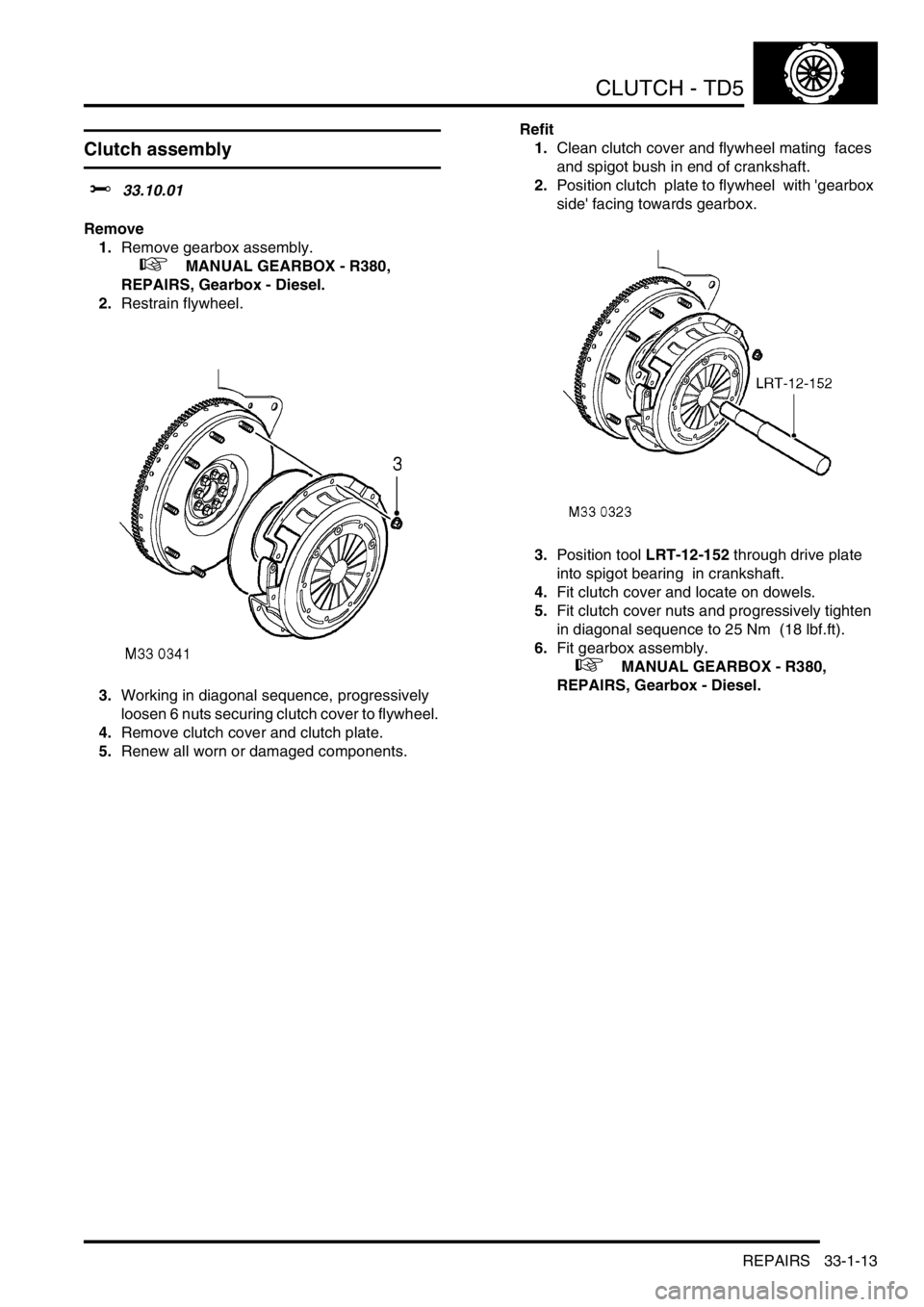flywheel LAND ROVER DISCOVERY 2002 Owner's Guide
[x] Cancel search | Manufacturer: LAND ROVER, Model Year: 2002, Model line: DISCOVERY, Model: LAND ROVER DISCOVERY 2002Pages: 1672, PDF Size: 46.1 MB
Page 656 of 1672

CLUTCH - TD5
DESCRIPTION AND OPERATION 33-1-5
1Brake/clutch reservoir
2Fluid supply pipe
3Hydraulic feed pipe
4Damper
5Master cylinder
6Piston
7Clutch pedal
8Primary driveshaft
9Engine crankshaft
10Drive plate
11Dual mass flywheel
12Ring gear
13Leaf spring
14Cover - pressure plate
15Diaphragm
16Release bearing
17Ball spigot
18Release bearing sleeve
19Release lever
20Slave cylinder
21Piston
22Bleed nipple
Page 657 of 1672

CLUTCH - TD5
33-1-6 DESCRIPTION AND OPERATION
Description
General
The clutch system is a diaphragm type clutch operated by a hydraulic cylinder. The drive plate is of the rigid centre
type with no integral damping springs. The flywheel is of the dual mass type with damping springs integral with the
flywheel. The clutch requires no adjustment to compensate for wear.
Hydraulic clutch
The hydraulic clutch comprises a master cylinder, slave cylinder and a hydraulic reservoir. The master and slave
cylinders are connected to each other hydraulically by plastic and metal pipes. The plastic section of the pipe allows
ease of pipe routing and also absorbs engine movements and vibrations.
The master cylinder comprises a body with a central bore. Two ports in the body connect the bore to the hydraulic
feed pipe to the slave cylinder and the fluid reservoir. The bore is also connected to a damper which prevents engine
pulses being transferred hydraulically to the clutch pedal. A piston is fitted in the bore and has an external rod which
is attached to the clutch pedal with a pin. Two coil springs on the clutch pedal reduce the effort required to depress
the pedal.
The master cylinder is mounted on the bulkhead and secured with two bolts. The cylinder is connected to the shared
brake/clutch reservoir on the brake servo by a braided connecting hose.
The slave cylinder is located on the left hand side of the gearbox housing and secured with two bolts. A heat shield
is fitted to protect the underside of the slave cylinder from heat generated from the exhaust system. The slave cylinder
comprises a cylinder with a piston and a rod. A port in the cylinder body provides the attachment for the hydraulic feed
pipe from the master cylinder. A second port is fitted witha bleed nipple used for removing air from the hydraulic
system after servicing. The piston rod locates on a clutch release lever located in the gearbox housing. The rod is
positively retained on the release lever with a clip.
Clutch mechanism
The clutch mechanism comprises a flywheel, drive plate, pressure plate, release lever and a release bearing. The
clutch mechanism is fully enclosed at the rear of the engine by the gearbox housing.
A clutch release bearing sleeve is attached in the gearbox housing with two bolts and located on two dowels. A spigot
with a ball end is formed on the release bearing sleeve and provides amounting and pivot point for the clutch release
lever. A dished pivot washer is located on the ball of the spigot. When the release lever is located on the ball, the pivot
washer seats against the rear face of the release lever. A spring clip is located on the lever and the pivot washer and
secures the lever on the spigot. A small bolt retains the spring clip in position.
The release lever is forked at its inner end and locates on the clutch release bearing carrier. The outer end of the
release lever has a nylon seat which locates the slave cylinder piston rod. A second nylon seat, positioned centrally
on the release lever, locates on the ball spigot of the release bearing sleeve and allows the release lever to pivot freely
around the ball.
The clutch release bearing locates on the clutch release lever and release bearing sleeve. The bearing is retained on
a carrier which has two flats to prevent the carrier rotating on the release lever. A clip retains the release lever on the
carrier. The bearing and carrier are not serviceable individually.
Page 658 of 1672

CLUTCH - TD5
DESCRIPTION AND OPERATION 33-1-7
Dual mass flywheel
1Ring gear
2Primary flywheel
3Inner drive plate
4Spring housing
5Secondary flywheel
6Rivet
7Ball bearing8Dowel location hole
9Mounting hole
10Inner spring
11Outer spring
12Crankshaft position sensing holes
13Pressure plate locating dowel
The dual mass flywheel is bolted on the rear of the crankshaft with eight bolts. A dowel on the crankshaft flange
ensures that the flywheel is correctly located. A ring gear is fitted on the outer diameter of the flywheel. The ring gear
is not serviceable. Thirty blind holes are drilled in the outer diameter of the flywheel adjacent to the ring gear. The
holes are positioned at 10
° intervals with four 20° spaces. The holes are used by the crankshaft position sensor for
engine management.
+ ENGINE MANAGEMENT SYSTEM - Td5, DESCRIPTION AND OPERATION, Description.
Page 659 of 1672

CLUTCH - TD5
33-1-8 DESCRIPTION AND OPERATION
The dual mass flywheel is used to insulate the gearbox from torsional and transient vibrations produced by the engine.
The flywheel comprises primary and secondary flywheels with the drive between the two transferred by a torsional
damper which comprises four coil springs. The springs are located in the inside diameter of the primary flywheel. Two
of the springs are of smaller diameter and fit inside the larger diameter springs.
The primary flywheel locates the ring gear and is attached to the crankshaft flange with eight bolts. The two pairs of
coil springs are located in a recess in the flywheel between two riveted retainers. A roller bearing is pressed onto the
central boss of the primary flywheel and retained with a riveted plate. The bearing provides the mounting for the
secondary flywheel.
The secondary flywheel comprises two parts; an outer flywheel which provides the friction surface for the clutch drive
plate and an inner drive plate which transfers the drive from the primary flywheel, via the coil springs, to the outer
flywheel. The two components of the secondary flywheel are secured to each other with rivets. The inner drive plate
is located between the two pairs of coil springs and can rotate on the ball bearing in either direction against the
combined compression force of the four coil springs. Under high torque loading conditions the secondary flywheel can
rotate in either direction up to 70
° in relation to the primary flywheel.
The operating face of the secondary flywheel is machined to provide a smooth surface for the drive plate to engage
on. Three dowels and six studs and nuts provide for the location and attachment of the pressure plate.
Pressure plate
1Leaf spring
2Drive plate
3Pressure plate
4Cover
5Diaphragm
6Rivet
Page 660 of 1672

CLUTCH - TD5
DESCRIPTION AND OPERATION 33-1-9
The pressure plate assembly comprises a pressure plate, cover and diaphragm and is mounted on and rotates with
the dual mass flywheel.
The pressure plate is forged from cast iron and machined to provide a smooth surface for the drive plate to engage
on. Three lugs on the outer diameter of the pressure plate connect it via three leaf spring to the cover. The leaf springs
have three tempered steel leaves which assist in pulling the pressure plate away from the drive plate when the clutch
pedal is depressed.
The cover is made from pressed steel and houses all pressure plate components. Shouldered rivets support the
diaphragm inside the cover. The rivets heads are chamfered to allow the diaphragm to pivot when pressure is applied
to it by the release bearing. Three holes in the cover locate on the dowels on the flywheel and six further holes provide
for the attachment of the cover to the flywheel with six nuts. Larger holes in the cover provide ventilation for the drive
plate and pressure plate and flywheel contact surfaces.
The diaphragm comprises a cast ring with eighteen fingers. The diaphragm is attached to the cover with nine
shouldered rivets. The inner head of each rivet is chamfered to allow the diaphragm to pivot when the clutch is
depressed or released. When pressure is applied to the fingers of the diaphragm by the release bearing, the
diaphragm pivots on the rivets and moves away from the pressure plate, releasing the force applied to the pressure
plate and allowing the drive plate to slip between the pressure plate and the flywheel.
Drive plate
1Friction material
2Inner plate
3Hub
4Spring steel plate
The drive plate is of the rigid centre type and is sandwiched between the flywheel and the pressure plate. The drive
plate has a splined hub which engages with the splines on the primary drive shaft from the gearbox. The hub is
attached to an inner plate which is pressed onto the hub. A spring steel plate is riveted to the inner plate with eight
rivets and provides the attachment surface for the drive plate friction material. The spring steel plate allows some axial
compliance and contributes to smooth clutch operation. The friction material comprises two 267 mm (10.5 in.) discs
which are secured with rivets to each side of the spring steel plate. The rivets are installed through recessed holes in
the disc and emerge in recessed holes in the opposite disc.
Page 661 of 1672

CLUTCH - TD5
33-1-10 DESCRIPTION AND OPERATION
Operation
Hydraulic operation
Refer to illustration.
+ CLUTCH - Td5, DESCRIPTION AND OPERATION, Hydraulic operation.
When the clutch pedal is depressed, the master cylinder piston is pushed into the master cylinder. The movement of
the piston pressurises the fluid in the master cylinder, forcing the pressurised fluid into the hydraulic feed pipe to the
slave cylinder. The hydraulic pressure is felt at the slave cylinder piston which moves under the hydraulic force
applied, pushing the clutch release lever via the piston rod.
When the clutch pedal is released, the force applied to the release lever by the fingers of the diaphragm, moves the
release lever, which pushes the slave cylinder piston into the cylinder. The displaced hydraulic fluid is pushed up the
hydraulic feed pipe and returns to the master cylinder.
Mechanism operation
When the clutch pedal is depressed, hydraulic pressure extends the piston and rod in the slave cylinder. The
extension of the piston pushes the rod against the outer end of the release lever which pivots around the ball spigot.
The inner end of the release lever pivots towards the engine applying pressure to the release bearing. The release
bearing slides along the release bearing sleeve and pushes on the fingers of the diaphragm. The diaphragm pivots
around the chamfered rivets in the cover. As the diaphragm is deflected, it removes pressure from the pressure plate.
The pressure plate moves away from the drive plate assisted by the three leaf springs.
The removal of force from the pressure plate on the drive plate reduces the friction between the dual mass flywheel,
drive plate and pressure plate. The drive plate slips between the flywheel and the pressure plate preventing rotary
movement being transferred from the flywheel and pressure plate to the primary driveshaft.
When the clutch pedal is released, hydraulic force is removed from the piston in the slave cylinder. This allows the
fingers of the diaphragm to push the release bearing along the release bearing sleeve. The movement of the release
bearing moves the release lever which pivots on the ball spigot, pushing the piston and rod back into the slave
cylinder.
The removal of pressure from the release bearing on the diaphragm, causes the diaphragm to pivot around the
chamfered rivets in the cover. The force applied to the pressure plate from the diaphragm overcomes the force of the
leaf springs and the pressure plate moves towards the drive plate and flywheel.
The pressure plate applies pressure to the drive plate which is pushed against the flywheel. As the clutch pedal is
progressively released, the friction between the drive plate, flywheel and pressure plate increases. The increase in
friction transfers the rotary movement of the flywheel and pressure plate to the drive plate, which in turn starts to rotate
the primary drive shaft. When the clutch pedal is released fully, the force applied by the diaphragm to the pressure
plate forces the drive plate onto the flywheel with no slippage.
Page 664 of 1672

CLUTCH - TD5
REPAIRS 33-1-13
REPAIRS
Clutch assembly
$% 33.10.01
Remove
1.Remove gearbox assembly.
+ MANUAL GEARBOX - R380,
REPAIRS, Gearbox - Diesel.
2.Restrain flywheel.
3.Working in diagonal sequence, progressively
loosen 6 nuts securing clutch cover to flywheel.
4.Remove clutch cover and clutch plate.
5.Renew all worn or damaged components.Refit
1.Clean clutch cover and flywheel mating faces
and spigot bush in end of crankshaft.
2.Position clutch plate to flywheel with 'gearbox
side' facing towards gearbox.
3.Position tool LRT-12-152 through drive plate
into spigot bearing in crankshaft.
4.Fit clutch cover and locate on dowels.
5.Fit clutch cover nuts and progressively tighten
in diagonal sequence to 25 Nm (18 lbf.ft).
6.Fit gearbox assembly.
+ MANUAL GEARBOX - R380,
REPAIRS, Gearbox - Diesel.
Page 670 of 1672

CLUTCH - V8
DESCRIPTION AND OPERATION 33-2-3
1Brake/clutch reservoir
2Connecting hose
3Bolt 2 off
4Master cylinder
5Clutch pedal
6Gearbox housing
7Primary driveshaft
8Bolt 2 off
9Slave cylinder
10Bleed nipple
11Pressure plate
12Drive plate
13Flywheel
14Metal hydraulic pipes
15Ball spigot
16Clutch release bearing sleeve
17Bolt 2 off
18Pivot washer
19Release lever
20Release bearing
21Retaining clip
22Bolt
23Bolt
Page 672 of 1672

CLUTCH - V8
DESCRIPTION AND OPERATION 33-2-5
1Brake/clutch reservoir
2Fluid supply pipe
3Hydraulic feed pipe
4Master cylinder
5Piston
6Clutch pedal
7Primary driveshaft
8Engine crankshaft
9Drive plate
10Flywheel
11Ring gear
12Cover - Pressure plate
13Leaf spring
14Retractor clip
15Diaphragm
16Release bearing
17Ball spigot
18Release bearing sleeve
19Release lever
20Slave cylinder
21Piston
22Bleed nipple
Page 673 of 1672

CLUTCH - V8
33-2-6 DESCRIPTION AND OPERATION
Description
General
The clutch system is a conventional diaphragm type clutch operated by a hydraulic cylinder. The clutch requires no
adjustment to compensate for wear.
Hydraulic clutch
The hydraulic clutch comprises a master cylinder, slave cylinder and a hydraulic reservoir, which is also shared with
the braking system. The master and slave cylinders are connected to each other hydraulically by plastic and metal
pipes. The plastic section of the pipe allows ease of pipe routing and also absorbs engine movements and vibrations.
The master cylinder comprises a body with a central bore. Two ports in the body connect the bore to the hydraulic
feed pipe to the slave cylinder and the brake/clutch fluid reservoir. A piston is fitted in the bore and has an external
rod which is attached to the clutch pedal with a pin. Two coiled springs on the clutch pedal reduce the effort required
to depress the pedal.
The master cylinder is mounted on the bulkhead in the engine compartment and secured with two bolts. The cylinder
is connected to the shared brake/clutch reservoir on the brake servo by a braided connecting hose.
The slave cylinder is located on the left hand side of the gearbox housing and secured with two bolts. A heat shield
protects the underside of the cylinder from heat generated from the exhaust system. The slave cylinder comprises a
cylinder with a piston and a rod. A port in the cylinder body provides the attachment for the hydraulic feed pipe from
the master cylinder. A second port is fitted with a bleed nipple for removing air from the hydraulic system after
servicing. The piston rod locates on a clutch release lever located in the gearbox housing. The rod is positively
retained on the release lever with a clip.
Clutch mechanism
The clutch mechanism comprises a flywheel, drive plate, pressure plate, release lever and a release bearing. The
clutch mechanism is fully enclosed at the rear of the engine by the gearbox housing.
A clutch release bearing sleeve is attached in the gearbox housing with two bolts and located on two dowels. A spigot
with a ball end is formed on the release bearing sleeve and provides a mounting and pivot point for the clutch release
lever. A dished pivot washer is located on the ball of the spigot. When the release lever is located on the ball, the pivot
washer seats against the rear face of the release lever. A spring clip is located on the lever and the pivot washer and
secures the lever on the spigot. A small bolt retains the spring clip in position.
The release lever is forked at its inner end and locates on the clutch release bearing carrier. The outer end of the
release lever has a nylon seat which locates the slave cylinder piston rod. A second nylon seat, positioned centrally
on the release lever, locates on the ball spigot of the release bearing sleeve and allows the release lever to pivot freely
around the ball.
The clutch release bearing locates on the clutch release lever and the release bearing sleeve. The bearing is retained
on a carrier which has two flats to prevent the carrier rotating on the release lever. A clip retains the release lever on
the carrier. The bearing and carrier are not serviceable individually.